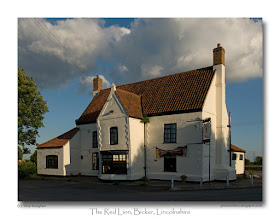 click photo to enlarge
click photo to enlargeThe evening shadows slowly enveloping the Red Lion pub at Bicker, Lincolnshire, could be a metaphor for the gloom that is snuffing out pub after pub in villages across Britain.
Those running village inns have been hit by the "double whammy" of the ban on smoking in public buildings and work places, followed by the recession. There were those, and I count myself among them, who welcomed the restrictions on smoking, thinking it would make places like pubs more customer friendly as well as healthier places to be. There was the feeling that whilst the new legislation would be a disincentive to smokers to continue to visit pubs (though many would, using the alternative arrangements that enabled them to smoke outside), this reduction in customers would be made up by the non-smokers who would now find the pubs more acceptable. Well, that doesn't seem to have happened: the number of smokers in pubs did decline, but the increase in non-smokers didn't compensate, and so landlords' incomes fell. That started the closures which hit pubs in cities and towns, but particularly those in villages with their smaller customer base and their reliance on the "passing trade." But it was the tightening of consumer spending brought on by the recession that accelerated the number of pubs permanently closing their doors. There are those who think this doesn't matter, and even some who celebrate the closures. However, the pub is a traditional and welcome feature of British life, offering not just drinks, but food and a meeting place. They inject life into their communities, and many are sorry to see them go.
It won't be all village pubs that close of course: many will find a way to struggle along until an upturn in the economy eases their situation. However, pubs in very small villages, like the one in the photograph, that has seen a turnover of three or four landlords in the past year or so, may well cease trading. This particular pub dates from the seventeenth century (a datestone at the top of the central gable says, "John Drury 1665"), and is built in what is described as a Fen Artisan Mannerist Style. It would be a shame if permanent closure prevented it celebrating, in 2065, four hundred years of serving beer to the village!
photograph & text (c) T. Boughen
Camera: Olympus E510
Mode: Aperture Priority
Focal Length: 18mm (36mm/35mm equiv.)
F No: f7.1
Shutter Speed: 1/500 seconds
ISO: 100
Exposure Compensation: -0.7 EV
Image Stabilisation: On